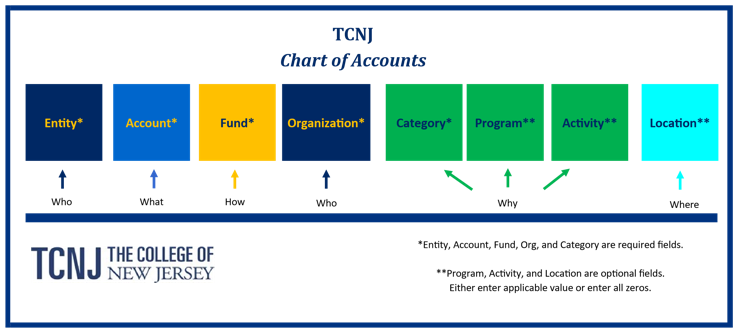The Chart of Accounts represents the structure through which financial transaction data is organized and reported. Implementing a new financial system represents an opportune time to redesign The College of New Jersey’s Chart of Accounts. The goal of redesigning the Chart of Accounts is to help resolve many of the financial and management reporting challenges faced by TCNJ today.
CoA Overview: Objectives
The College of New Jersey (TCNJ) initiated a project to review and redesign the Chart of Accounts (CoA) as a precursor to the Oracle Cloud Implementation. The redesign effort was oriented toward achieving several objectives:
- Enhance the Campus’s capacity for financial management and reporting across all levels of the organization – central campus administration, campus auxiliaries and support organizations, academic departments and programs, the foundation and Trenton State College Corporation (TSCC)
- Establish a CoA that aligns with and optimizes the structure and functionality delivered in modern financial systems and adopting the key principles of a multidimensional chart of accounts
- Establish CoA recommendations that adopt best practice in CoA definition and use as well as align with Oracle Cloud Finance functionality
- Ensure CoA supports the accounting for funds, programs, activities and projects at the campus, academic, and administrative department levels.
- Establish a CoA structure that considers the fiscal management needs at all levels of the College to reduce the reliance on shadow systems, inconsistent use of the CoA, and help ensure the integrity of the College’s financial data.
CoA Guiding Principles
Establishing Guiding Principles early in the design effort provides a basis for decision making and will help define parameters, design and use of CoA
- The CoA should serve as the common language for all financial processes and systems
- The CoA should accommodate growth and adapt to changing business needs
- Detailed data captured in subsidiary applications and programs should not be duplicated in the CoA
- Each segment or element of the CoA should be defined and serve a single purpose
- Segment use and hierarchies should be consistently designed to best support the College external and management reporting
- CoA should allow for consistent recording of financial transactions to support department reporting across the College
Chart of Accounts Town Hall Presentation April 30, 2019
Additional Chart of Account (CoA) information sessions will be scheduled in the coming months. If you are interested in attending future meetings or if you would like to set up a meeting for your specific department please complete this CoA Department Discussion – Interest Survey.
Chart of Accounts Blog Post April 17, 2019
When we move to Oracle Cloud, the chart of accounts (CoA, currently known as chartfields in PeopleSoft) will change dramatically. Currently, there are six chartfield segments (account, fund, department, class, program and project) that are used in different combinations depending on the fund that is being used. The Oracle Cloud CoA will have nine segments (entity, account, fund, organization, category, program, activity, location, and future) and all segments will need to be populated with a value. The College redesigned its CoA for Oracle Cloud for multiple reasons, including:
- To expand the amount of information about a transaction captured within the system;
- To improve the consistency of the information captured by each segment;
- To enhance the College’s ability to report on budgets and actuals at the aggregate and detail levels across CoA segments; and
- To provide flexibility for future growth and needs.
You may notice that project (currently used for grants and capital projects) is not a segment in the new CoA. Projects and grants will be maintained in a separate module in Oracle Cloud called Project Portfolio Management (PPM) which uses a different string of values (called POET): project, organization, expenditure type (similar to account), and task. The POET values capture information about expenditures that are only needed for projects and grants without having to add additional segments to the CoA. The POET values are linked to CoA values so project and grant expenditures can be included in reports at the aggregate level, such as a report of all budgets and expenses for a school or academic department.
In the coming weeks and months there will be much more information offered on the new CoA and tools will be available to translate your current chart fields into the new CoA and view all available CoA values.

